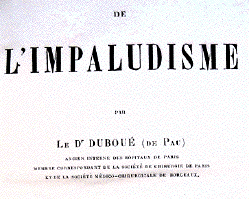
mardi 1er avril 2014 la lettre d'information du site baillement.com N°128 Si vous ne voyez pas les images, cliquez ici pour lire cette lettre dans votre navigateur. If you cannot see pictures below, to view the email in your web browser click here baillement.com est libre d'accès, base documentaire pour comprendre, chercher, travailler
-
Different yawns, different functions? - Testing social hypotheses on spontaneous yawning in Theropithecus gelada
- Leone A, Ferrari PF, Palagi E
- Scientific Reports
- 2014;4;4010
- In Bonobos Yawn Contagion Is Higher among Kin and Friends
- Demuru E, Palagi E
- PLoS One
- 2012; 7(11): e49613
- Aggression does not increase friendly contacts among bystanders in geladas (Theropithecus gelada)
- Leone A, Mignini M, Mancini G, Palagi E
- Primates
- 2010;51(4):299-305
- Yawn Contagion and Empathy in Homo sapiens
- Norscia I, Palagi E
- PLoS ONE
- 2011;6(12): e28472
- Contagious yawning in gelada baboons as a possible expression of empathy
- Palagi E, Leone A, Mancini G, Ferrari PF
- Proc Natl Acad Sci USA
- 2009;106(46):19262-19267
-
Yawning and social contexts by geladas - Here, the authors tested hypotheses about the potential functions of yawning based on its intensity and social contexts. Due to their spectrum intensity of yawns (covered teeth/YW1; uncovered teeth/YW2; uncovered gums/YW3), geladas are a good model species for this purpose.
- They suggest that yawns of different intensity can bear different information according to the performer, the context and the behavioural pattern temporally associated to the yawn event.
- YW3, mainly performed by high ranking males during periods of high social tension, was frequently associated with an auditory component and often accompanied by scratching (a measure of anxiety).
- YW1 and YW2, preferentially performed by females, were frequently associated to lip smacking, an affiliative display.
- In conclusion, even though a clear-cut functional distinction of geladas' yawn intensity is difficult, YW1 and YW2 seem to be more linked to affiliative social interactions; whereas, YW3 seems to be more linked to agonistic and tension situations.

- Contexte social du bâillement chez les singes geladas
- Dans ce travail, les auteurs ont testé des hypothèses sur les fonctions potentielles du bâillement en fonction de son intensité expressive et du contexte social durant lequel il survient.
- En raison de la grande variété de leurs bâillements (dents couvertes; dents découvertes; gencives et dents découvertes), l'espèce des singes geladas est apparue comme un bon modèle pour cette étude.
- Les auteurs suggèrent que des bâillements d'aspects différents peuvent véhiculer des informations variables suivant le rang social, le contexte et les liens affecifs adaptés aux circonstances de la vie sociale.
- Les bâillements à dents découvertes sont principalement le fait de mâles domiants pendant les périodes de forte tension sociale et ont souvent été associés à une composante sonore et au grattage/scratching, témoin de l'anxiété.
- Les bâillements avec ou sans dents visibles
mais gencives masquées surviennent principalement
chez les femmelles et ont été
fréquemment associés à des
claquements des lèvres, marqueur
d'affinité.
En conclusion, même si une distinction fonctionnelle claire des différentes modalités des bâillements chez les singes geladas est difficile, les bâillements, avec ou sans dents visibles, semblent être plus liés à des interactions sociales positives, tandis que les bâillements à gencives découvertes semblent être plus liés à des situations d'agressivité et de tension.
-
Emotional stress evoked by classical fear conditioning induces yawning behavior in rats - Kubota N, Amemiya S, Yanagita S, Nishijima T, Kita I
- Neurosci Lett
- 2014;566C:182-187
- Punishment-Induced Fear Modifies the Daily Course of Yawning in Rats
- Moyaho A, Valencia J
- Front Neurol Neurosci
- 2010;28: 77-83
-
Emotional stress may induce yawning behavior - Yawning is often observed not only in a state of boredom or drowsiness but also in stressful emotional situations, suggesting that yawning is an emotional behavior. However, the neural mechanisms for yawning during stressful emotional situations have not been fully determined, though previous studies have suggested that both parvocellular oxytocin (OT) and corticotropin-releasing factor (CRF) neurons in the hypothalamic paraventricular nucleus (PVN) are responsible for induction of yawning.
- Thus, using ethological observations and c-Fos immunohistochemistry, the authors examined whether emotional stress evoked by classical fear conditioning is involved in induction of yawning behavior in freely moving rats. Emotional stress induced yawning behavior that was accompanied by anxiety-related behavior, and caused neuronal activation of the central nucleus of the amygdala (CeA), as well as increases in activity of both OT and CRF neurons in the PVN. These results suggest that emotional stress may induce yawning behavior, in which the neuronal activation of the CeA may have a key role.
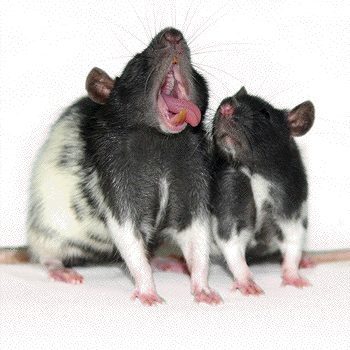
- Le stress émotionnel peut induire des bâillements
- Le bâillement est souvent observé non seulement dans les moments d'ennui ou de somnolence, mais aussi, dans des situations émotionnelles stressantes, ce qui suggère que le bâillement est un comportement émotionnel. Cependant, les mécanismes neuronaux du bâillement, au cours de ces situations, n'ont pas été entièrement déterminées, bien que des études précédentes aient suggéré que les neurones ocytocinergiques (OT) et corticotropes (CRF) du noyau paraventriculaire hypothalamique (PVN) étaient responsables de l'induction du bâillement.
- C'est pourquoi, les auteurs ont examiné, à partir d'observations éthologiques et d'immunohistochimie, c-Fos, si le stress émotionnel suscité par la peur (avec un conditionnement classique) est impliqué dans l'induction des bâillements chez des rats se déplaçant librement.
- Le stress émotionnel induit bien un comportement de bâillements. Celui-ci a été accompagné par des comportements liés à l'anxiété, et a provoqué l'activation neuronale du noyau central de l'amygdale (CEA), ainsi que l'augmentation de l'activité des neurones OT et CRF dans le PVN. Ces résultats suggèrent que le stress émotionnel peut induire un comportement de bâillement dans lequel l'activation neuronale du CEA peut jouer un rôle clé.
- -Kita I, Kubota N, Yanagita S, Motoki C Intracerebroventricular administration of corticotropin-releasing factor antagonist attenuates arousal response accompanied by yawning behavior in rats. Neurosci.Letter 2008;433(3):205-208
- -Kita I, Yoshida Y, Nishino S. An activation of parvocellular oxytocinergic neurons in the paraventricular nucleus in oxytocin-induced yawning and penile erection. Neurosci Res. 2006;54(4):269-275
- -Kita I, Seki Y, Nakatani Y, Fumoto M, Oguri M, Sato-Suzuki I, Arita H. Corticotropin-releasing factor neurons in the hypothalamic paraventricular nucleus are involved in arousal/yawning response of rats. Behav Brain Res. 2006;169(1)48-56.
- -Kita I, Sato-Suzuki et al.Yawning responses induced by local hypoxia in the paraventricular nucleus of the rat.Behavioural Brain Research 2000;117(1-2):119-126
- -Kubota N, Amemiya S, Motoki C, Otsuka T, Nishijima T, Kita I. Corticotropin-releasing factor antagonist reduces activation of noradrenalin and serotonin neurons in the locus coeruleus and dorsal raphe in the arousal response accompanied by yawning behavior in rats. Neurosci Res. 2012;72(4):316-323
- -Kubota N, Amemiya S, Yanagita S, Nishijima T, Kita I. Emotional stress evoked by classical fear conditioning induces yawning behavior in rats. Neurosci Lett. 2014 Mar 11.
- -Seki Y, Y Nakatani, et al Light induces cortical activation and yawning in rat Behav Brain Res 2003;140(1-2):65-73
- -Seki Y, Sato-Suzuki I, et al Yawning/cortical activation induced by microinjection of histamine into the paraventricular nucleus of the rat. Behav Brain Res. 2002;134(1-2):75-82.
- -Sato-Suzuki I, Kita I, Oguri M, Arita H Stereotyped yawning responses induced by electrical and chemical stimulation of paraventricular nucleus of the rat Journal of Neurophysiology, 1998;80(5)2765-2775
- -Sato-Suzuki I, I Kita, Seki Y, M Oguri, H Arita Cortical arousal induced by microinjection of orexins into the paraventricular nucleus of the rat Behavioural Brain Research 2002;128:169-177
-
Zerebrale Zystizerkose: - Ein Fallbericht
- Auer H, Feldner-Bustin G, Hermentin K, Kollegger H, Schmidbauer M
- Mitt. Osterr. Ges Tropenmed, Parasilol
- 1987;9:101-109
-
Cerebral cysticercosis - Neurocysticercosis (NCC) is a neglected tropical disease caused by larval forms of the parasite Taenia solium lodging in central nervous system (CNS). NCC is a major cause of epilepsy in regions where pigs are free-ranging and hygiene is poor.
- There is a huge morbidity and debilitation due to CNS manifestations of NCC in developing and underdeveloped regions of the globe, mainly Asian, African and Latin American countries. It is the cause of epilepsy in about 1% of the population of endemic countries and is the underlying etiology in about 15-50% persons with epilepsy, depending upon the geographical region.
- There is no perfect diagnostic method and the diagnosis relies on a combination of clinical, radio-imaging, immunologic and epidemiologic data. Treatment includes anti-parasitic treatment by cysticidal drugs and management of associated symptoms and complications. The disease is eradicable and control depends on an integrated and coordinated involvement of international bodies like the World Health Organization along with scientific institutions and political and administrative strata of the endemic countries to provide the essential tools such as adequate sanitation, live-stock management, health education and improved socio-economic conditions.
- Neurocysticercose
- La Neurocysticercose (NCC) est une maladie tropicale, négligée, provoquée par les larves du parasite Taenia solium, hébergées dans le système nerveux central. La NCC est une cause fréquente d'épilepsie dans les régions où les porcs sont en liberté et l'hygiène est inexistante.
- La morbidité est importante dans certains pays asiatiques, africains et latino-américains. La cysticercose est la cause de l'épilepsie chez environ 1% de la population des pays d'endémie. C'est l'étiologie chez environ 15 à 50% des personnes souffrant d'épilepsie dans ces pays.
- Il n'existe aucune méthode de diagnostic idéale et le diagnostic repose sur une combinaison de la clinique, de la radio-imagerie, de tests immunologiques et des données épidémiologiques. Le traitement comprend le traitement anti-parasitaire, des crises convulsives et des complications associées. La maladie ne sera éradiquée que par une participation intégrée et coordonnée des organismes internationaux comme l'Organisation mondiale de la santé ainsi que des institutions scientifiques, politiques et administratives des pays d'endémie. Les mesures essentielles sont un assainissement adéquat, la gestion du bétail infecté, l'éducation et l'amélioration des conditions socio-économiques.
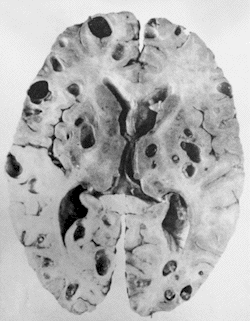
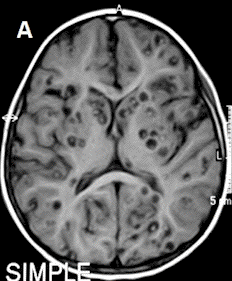
- A case report with yawning salvos
- A case of human neurocysticercosis is reported. The patient was a Yugoslavian foreign worker who developed neurological symptoms and was thus hospitalized. The results of electro-encephalogram, computed tomography and cerebrospinal fluid analysis as well as the geographic anamnesis of the patient led to the preliminary diagnosis "cerebral cysticercosis" or "cerebral echinococcosis" respectively. Clinically, he showed seizures, and bursts of repeated yawning The diagnosis could not be confirmed by serological examinations. The problems of serodiagnosis of cerebral cysticercosis are discussed.
- Zerebrale Zystizerkose: Ein Fallbericht
- Neurologischer Status:
- Kein Meningismus; Pupillomotorik unauffäillig; grobschlägiger, nicht erschöpfbarer Blickrichtungsnystagmus beim Lateralblick bds.; Masseterreflex gesteigert, der übrige Hirnnervenbereich unauffâllig; an den Extremitâäten hinsichtlich Trophik und Tonus seitengleich unauffällige; Verhältnisse; diffuse Reduktion der groben Kraft am rechten Arm; grobe Kraft an der unteren Extremität seitengleich gut; Hypodiadochokinese bds.; Muskeleigenreflexe an der oberen Extremität bds. lebhaft mit deutlichem Rechtsakzent auslösbar; an der unteren Extremität seitengleich lebhaft; Py-Zeichen nicht sicher positiv; Sensibilitat aufgrund der Sprachbarriere nicht beurteilbar; Greif- und Schnauzreflex positiv; Nestelbewegungen; starkes Gähnen.
- Une observation avec salves de bâillements
- Un cas de cysticercose humaine est rapporté ici. Le patient était un travailleur originaire de Yougoslavie qui a développé des symptômes neurologiques pour lesquels il est hospitalisé. Les résultats de l'électro-encéphalogramme, le scanner cérébral et l'analyse du liquide céphalo-rachidien, ainsi que l'anamnèse géographique du patient, conduit au diagnostic "de neurocysticercose" ou "échinococcose cérébrale". Cliniquement, à côté des convulsions, il manifestait des salves de bâillements répétés. Le diagnostic n'a pas pu être confirmé par les examens sérologiques.
-
Paul Strand eng - A yawning woman
- New York
- 1917
- Paul Strand fr
-
Wooes Morpheus - "I have found a cure for a person who isn't chronically afflicted with insomnia, but who temporarily cannot sleep. It is a curious thing that the picture of a person yawning will almost invariably induce sleep" said a physician.
- Try it yourself some time if you come across such a photograph. For the life of you you, can't help yawning, after a moment, and persistent gazing at the sleepy head will almost inevitably send you to the couch for a nap."
- The New York Times in 'Amador Ledger', 6 December 1901
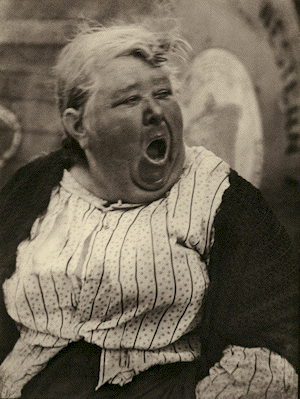
- Comment courtiser Morphée
- "J'ai trouvé un remède pour une personne, non pas affligée d'insomnie chronique, mais qui, temporairement, ne peut pas dormir. C'est une chose bien curieuse, l'image d'une personne qui bâille, presque invariablement, induit le sommeil " a déclaré un médecin.
- Essayez vous-même si vous tombez sur une telle photographie ! Si cela ne vous aide pas, regardez fixement et de façon prolongée, un visage endormi. Presque inévitablement, cela va vous envoyer vers le canapé pour une sieste "
-
De l'impaludisme 1867 - Pierre-Henri Duboué de Pau
- 1834-1889
- Quant à certains autres symptômes, liés à l'acte respiratoire, tels que les bâillements, le hoquet, le ronflement, on les observe parfois dans l'intoxication palustre. Tout le monde sait que les accès de fièvre intermittente débutent très souvent par des bâillements et des pandiculations et qu'un hoquet opiniâtre se montre dans certaines formes d'affections palustres. J'ai vu, pour ma part, une douzaine d'exemples où ce dernier symptôme était prédominant, et j'ai toujours remarqué qu'il accompagnait d'ordinaire les formes perniceuses ou tendant a s'aggraver. Mais, ce que tout le monde ne sait pas, c'est que le ronflement accompagne certaines formes cérébrales et notamment la forme comateuse, dont je n'ai vu que trois exemples. Je rapporterai un peu plus loin (voir obs. XXVII) un cas des plus remarquables où ce symptôme était le seul indice d'une affection maremmatique des plus réelles.
- Maremmatique = Qui tient de la maremme, terrain marécageux en Italie centrale, notamment le long de la mer Tyrrhénienne
- Les fièvres maremmatiques terme ancien ddésigant le paludisme.
-
Autres documents mis en ligne ce mois-ci :
- Claudien Phlippe (1866-1903), une bographie
- Raymond Cestan (1872-1933), une biographie
- Individual Variation in Contagious Yawning Susceptibility Is Highly Stable and Largely Unexplained by Empathy or Other Known Factors. Bartholomew et al.
- Emotional stress evoked by classical fear conditioning induces yawning behavior in rats. Kubota N et al.
- Chimpanzees empathize with group mates and humans, but not with baboons or unfamiliar chimpanzees. Campbell M et al.
Résultats du sondageau 31 mars 2014 Recherche par mot du site
-
Nombre de questionnaires remplis : 6759 - Combien de fois bâillez-vous par jour ? <5 = 23,2%.. 5-10 = 22,1%.. 10-15 = 15,2%.. 15-20 = 10,9%.. >20 = 28,5%
- Ressentez-vous des baillements excessifs ?
- 51,7% = non, tant mieux
- 37,5% = oui et je ne sais pas pouquoi
- 9% = oui et je prends des antidépresseurs
- 1,1% = oui et je prends des anti-épileptiques
- 6,3% = oui et je prends d'autres médicaments
- 2,3% = oui et j 'ai des troubles neurologiques
- 2,4% = oui et j 'ai des troubles hormonaux
- 1,3% = oui et j 'ai des tics moteurs
- 1,6% = oui et j 'ai des tocs
- déclenchez-vous facilement le bâillement d'autrui ? 74,4%
- êtes-vous sensible au bâillement d'autrui ? 68,2%
- Judith Schlangers, 1991
- An opinion is sometimes excluded, before or after having been accepted, and is however agreed with later on, in another context, and often for other reasons.
- The way of locating in time the precursory opinion is somewhat special. It is indeed ill-timed, new and innovating at the time of it's fruitful use, present when it is used, but with a cultural index of deracination.
- Il arrive parfois qu'une proposition soit rejetée, avant d'être réintégrée, ou après l'avoir été, qu'elle soit reprise ultérieurement, dans un autre contexte, et souvent pour d'autres raisons.
- L'idée novatrice a toujours un parcours inattendu caractérisé par son inadaptation chronologique. Hors du contexte ambiant lors de sa formulation, elle s'épanouit grâce à sa nature innovante, à un moment imprévu, bien différent de celui qui l'a vue éclore, en particulier dans une toute autre ambiance culurelle.
baillement.com baillement.info yawning.info écrits et réalisés par le Dr Walusinski
